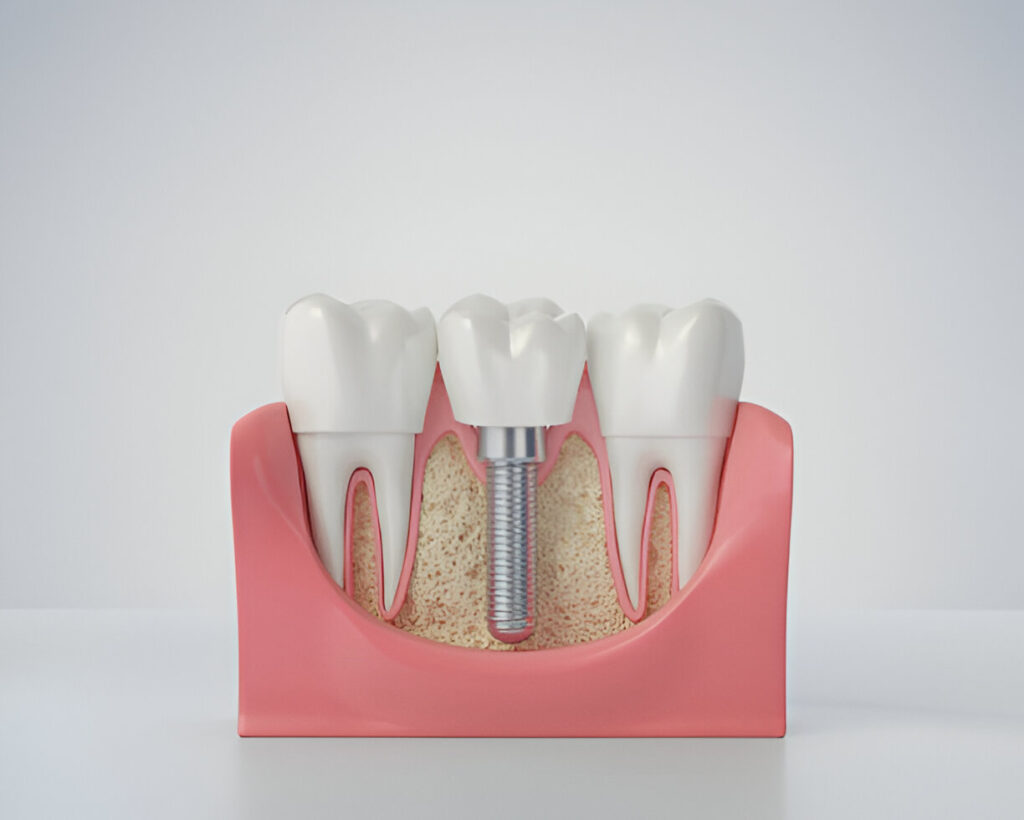Losing teeth can have a significant impact on your smile, your confidence, and your ability to eat comfortably. Fortunately, dental implants offer a permanent solution for replacing missing teeth. But, can one implant truly replace two teeth? In this article, we’ll explore how one dental implant can replace two missing teeth and the factors to consider before opting for this innovative procedure.
What is a Dental Implant?
A Dental implants is a small titanium post that is surgically placed into your jawbone. This post acts as a replacement for the root of a missing tooth. After the implant is placed, a crown (the artificial tooth) is attached to the implant, restoring the appearance and function of the missing tooth.
Dental implants are popular because they are durable, look natural, and can last a lifetime with proper care. They are often used to replace single teeth, but with advancements in dental technology, it’s now possible to use one implant to replace two adjacent teeth in certain cases.
What To Eat After Dental implant Surgery UK
How Can One Implant Replace Two Teeth?
In the past, replacing two missing adjacent teeth would require two separate dental implants. However, advancements in implant technology have made it possible to replace two teeth with a single implant. This method is typically used when the missing teeth are next to each other, and the adjacent teeth are healthy enough to support the replacement.
How Long Before Dental Implants Feel Normal?
There are two primary methods used for replacing two teeth with one implant:
- Cantilever Bridges: A cantilever bridge involves using a single implant to support a prosthetic tooth (or teeth) that are suspended between the implant and adjacent natural teeth. The adjacent teeth must be strong and healthy enough to support the bridge.
- Implant-Supported Bridges: This method involves using a single implant to support a bridge that spans the gap between the missing teeth. This approach can replace multiple teeth while reducing the number of implants required.
Both methods are effective in restoring the appearance and function of your teeth while minimizing the number of implants needed.
Can You Have Dental Implants with Gum Disease in the UK?
Benefits of Replacing Two Teeth with One Implant
There are several advantages to using one implant to replace two teeth:
- Reduced Surgical Time: One implant means only one surgical procedure, reducing the time needed for the implant process and recovery. This can be particularly beneficial for people who prefer a quicker treatment.
- Cost-Effective: Dental implants can be expensive, so using one implant to replace two teeth can reduce the overall cost compared to placing two separate implants. This makes it an attractive option for people looking to restore multiple teeth while staying within budget.
- Preserving Adjacent Teeth: By using a single implant to replace two teeth, you avoid the need to alter the healthy teeth adjacent to the missing ones. In contrast, traditional methods like bridges often require grinding down the nearby teeth.
- Less Invasive: Fewer implants mean fewer surgical procedures. This can make the recovery process less invasive and more comfortable for the patient.
What Are Dental Implants Made Of?
Considerations Before Choosing One Implant for Two Teeth
While the idea of replacing two teeth with one implant may sound appealing, it’s not suitable for everyone. There are several factors to consider before opting for this approach:
- Jawbone Health: For the implant to be successful, you need enough healthy jawbone to support it. If your jawbone has deteriorated due to bone loss, the dentist may need to perform a bone graft before placing the implant.
- Gum Health: Healthy gums are crucial for the success of dental implants. If you have gum disease or inflammation, these conditions need to be treated before proceeding with the implant.
- Location of the Missing Teeth: This approach is most commonly used for front teeth where the forces on the teeth are less intense. For back teeth, where the forces from chewing are stronger, two separate implants may be necessary for adequate support.
- Condition of Adjacent Teeth: The adjacent teeth must be healthy and strong enough to support the implant and the attached prosthetic teeth. If these teeth are weak or damaged, the dentist may recommend two separate implants.
When is it Too Late to Get Dental Implants
How Long Does the Procedure Take?
The process of replacing two teeth with one implant typically takes several months. Here’s what to expect:
- Initial Consultation: During your first visit, the dentist will examine your mouth, take X-rays, and discuss your options. This will help determine whether you’re a good candidate for this procedure.
- Implant Placement: The implant will be placed into your jawbone during a minor surgical procedure. The implant will need several months to fuse with the bone in a process called osseointegration.
- Healing and Recovery: After the implant is placed, you’ll need time to heal. This can take several months, and it’s important to follow your dentist’s instructions during this time to ensure proper healing.
- Final Restoration: Once the implant has fully integrated with the bone, the dentist will place a custom-made prosthetic tooth or bridge to complete the restoration.
Can You Lose Your Gums Around Dental Implants?
Potential Risks and Challenges
While the process of replacing two teeth with one implant is generally safe and effective, there are some risks and challenges:
- Implant Failure: In rare cases, the implant may fail to properly integrate with the jawbone, which could require the procedure to be repeated.
- Infection: As with any surgical procedure, there is a risk of infection. Following post-operative care instructions is essential to avoid complications.
- Implant Movement: If the adjacent teeth are not strong enough to support the implant, it may cause discomfort or lead to implant movement over time.
How Much Are All-on-4 Dental Implants in the UK?
Conclusion
Replacing two teeth with one implant is an innovative and cost-effective solution for many patients. This approach offers several benefits, including reduced treatment time, lower costs, and less invasive surgery. However, it is essential to consider factors like jawbone and gum health, as well as the condition of adjacent teeth, before opting for this treatment. By consulting with a qualified dental professional, you can determine if this procedure is right for you.
If you’re considering dental implants to replace missing teeth, it’s essential to schedule a consultation with your dentist to explore your options. With advancements in dental technology, you can achieve a functional and natural-looking smile that lasts for years to come.
Take the Next Step with Holburn Dental and Implant Centre
If you’re considering dental implants to replace missing teeth, including the possibility of using one implant to replace two teeth, we’re here to help. At Holburn Dental and Implant Centre, our team of experts provides tailored solutions to restore your smile and enhance your oral health. Schedule a consultation today to explore your options and receive personalised advice on the best treatment plan for your needs. Let us help you achieve a confident, healthy smile that lasts!
FAQs About Replacing Two Teeth with One Implant
Can one implant replace two teeth in the back of the mouth?
It’s possible in some cases, but usually, separate implants are needed for back teeth. The stronger chewing forces on these teeth require individual support to ensure long-term stability.
How long do dental implants last?
Dental implants can last a lifetime with proper care. Regular brushing, flossing, and check-ups with your dentist can help maintain the implant’s health and longevity.
Is the procedure painful?
Dental implant surgery is performed under local anaesthesia, so you shouldn’t feel pain during the procedure. Some discomfort may occur during recovery, but it’s usually manageable with over-the-counter pain relievers.
How long does the healing process take?
It typically takes 3 to 6 months for the implant to fully integrate with the jawbone. The overall treatment time can take several months due to the healing period and the final placement of the restoration.
Can I eat normally after the implant is placed?
After the implant is placed, you may need to follow a soft-food diet for a few weeks while your jawbone heals. Once healed, you can eat normally, and the implant should function like a natural tooth.
For more information visit


